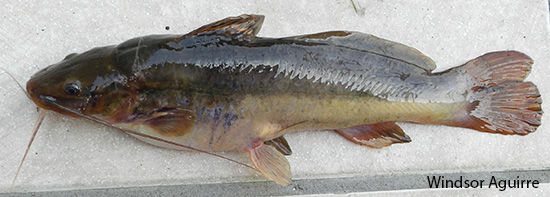Heptapteridae - Rhamdia cinerascens (Gunther, 1860) |
 |
| *Specimen from Chongon Reservoir near city of Guayaquil* |
| SOURCE FOR OCCURRENCE IN ECUADOR: This species is very common in the Guayas River drainage, Portoviejo River and Esmeraldas River. There are many references for its occurrence in the area (e.g., Eigenmann, 1922; Ovchynnyk, 1971; Barnhill et al., 1974; Glodek, 1978; Florencio, 1993; Lopez et al, 1993; Ferraris, 2007; Laaz et al., 2009; Prado, 2009; Revelo, 2010; Laaz & Torres, 2010).
|
| ORIGINAL DESCRIPTION: Günther, A. 1860. Third list of cold-blooded vertebrata collected by Mr. Fraser in Ecuador. Proceedings of the Zoological Society of London 1860 (pt 2) (art. 8): 233-240, Pisces Pl. 10. |
| TYPE SPECIMENS: |
| TAXONOMIC STATUS: Valid (Eschmeyer and Fricke, 2020). This species was formally known as Rhamdia quelen and R. wagneri in western Ecuador. We follow Hernandez et al. (2015) for its nomenclature. |
| RANGE ECUADOR: Guayas River drainage, Portoviejo River, and Esmeraldas River. |
| RANGE OUTSIDE OF ECUADOR: Historically, there has been much taxonomic confusion on the identitity of the species of Rhamdia in western Ecuador and it had been recognized under the names R. wagneri and the broadly distributed R. quelen. It now appears that R. cinerascens is a valid species and is endemic to western Ecuador (Hernandez, 2015). |
| COLLECTIONS IN ECUADOR: |
| MAXIMUM SIZE: Reported to a maximum of 38.6 cm by Barnhill Les et al. (1974). Laaz et al. (2009) reported that it possibly grows to 40 cm. |
| DISTINGUISHING FEATURES: This species is distinguished from other Rhamdia species in South America by a large head with head length 25.8–30.1% of standard length, base of the
adipose fin 30.3–33.3% of standard length, outer mental barbels extending to the base of the pectoral rays, and
presence of a faint lateral longitudinal band (Hernandez et al., 2015). It can be distinguished from Pimelodella in western Ecuador, which are morphologically similar to small Rhamdia, because the posterior projection of the occipital process does not extend to the dorsal fin origin (Glodek, 1978).
|
| ECOLOGY: This species is known as the “barbudo” in western Ecuador. It is a large, ecologically important, omnivorous fish that is mostly active at night. It occurs from the foothills of mountains throughout low elevation streams and rivers and typically hides during the day amongst vegetation, branches and rocks. It prefers slow moving waters and feeds on aquatic insects, small fish, and plant material that falls into rivers such as fruits, seeds and flowers. Its reproduction is synchronized with the rainy season (Ortega-Lara et al., 1999 in Maldonado, 2005).
|
| ECONOMIC IMPORTANCE: This is an important food fish for people in western Ecuador (Prado, 2009; Revelo, 2010). |
| CONSERVATION STATUS: NA, although the species is heavily exploited as a food species and anecdotal evidence suggests it is declining in abundance. |
| LINK TO FISHBASE PAGE: Click here for link |
| SPECIES PROFILE CREATED BY: Enrique Laaz |
| SPECIES PROFILE CONTRIBUTORS: Windsor Aguirre |
|
|
|
|
|
